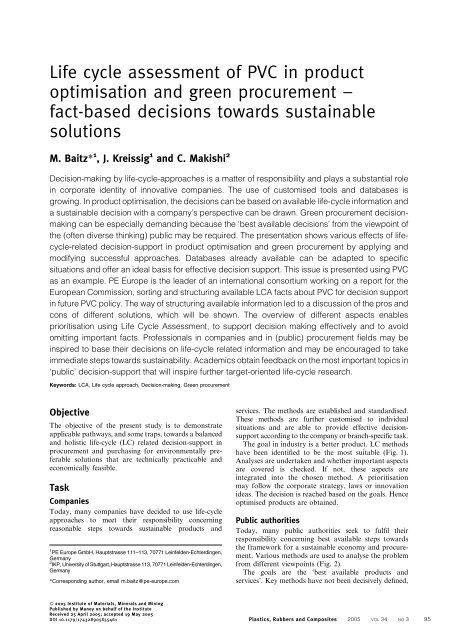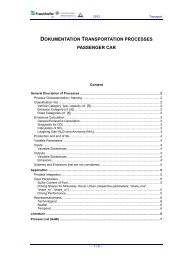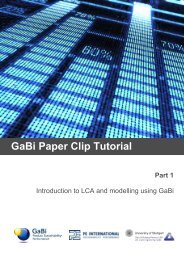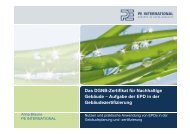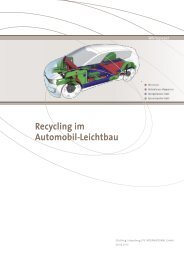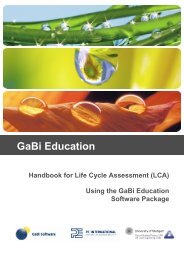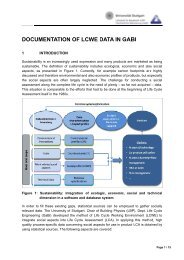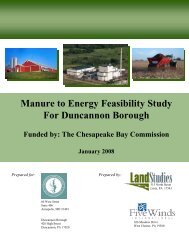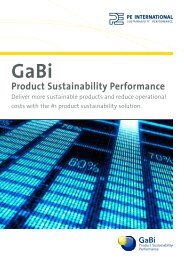here - GaBi Software
here - GaBi Software
here - GaBi Software
You also want an ePaper? Increase the reach of your titles
YUMPU automatically turns print PDFs into web optimized ePapers that Google loves.
Life cycle assessment of PVC in product<br />
optimisation and green procurement –<br />
fact-based decisions towards sustainable<br />
solutions<br />
M. Baitz* 1 , J. Kreissig 1 and C. Makishi 2<br />
Decision-making by life-cycle-approaches is a matter of responsibility and plays a substantial role<br />
in corporate identity of innovative companies. The use of customised tools and databases is<br />
growing. In product optimisation, the decisions can be based on available life-cycle information and<br />
a sustainable decision with a company’s perspective can be drawn. Green procurement decisionmaking<br />
can be especially demanding because the ‘best available decisions’ from the viewpoint of<br />
the (often diverse thinking) public may be required. The presentation shows various effects of lifecycle-related<br />
decision-support in product optimisation and green procurement by applying and<br />
modifying successful approaches. Databases already available can be adapted to specific<br />
situations and offer an ideal basis for effective decision support. This issue is presented using PVC<br />
as an example. PE Europe is the leader of an international consortium working on a report for the<br />
European Commission, sorting and structuring available LCA facts about PVC for decision support<br />
in future PVC policy. The way of structuring available information led to a discussion of the pros and<br />
cons of different solutions, which will be shown. The overview of different aspects enables<br />
prioritisation using Life Cycle Assessment, to support decision making effectively and to avoid<br />
omitting important facts. Professionals in companies and in (public) procurement fields may be<br />
inspired to base their decisions on life-cycle related information and may be encouraged to take<br />
immediate steps towards sustainability. Academics obtain feedback on the most important topics in<br />
‘public’ decision-support that will inspire further target-oriented life-cycle research.<br />
Keywords: LCA, Life cycle approach, Decision-making, Green procurement<br />
Objective<br />
The objective of the present study is to demonstrate<br />
applicable pathways, and some traps, towards a balanced<br />
and holistic life-cycle (LC) related decision-support in<br />
procurement and purchasing for environmentally preferable<br />
solutions that are technically practicable and<br />
economically feasible.<br />
Task<br />
Companies<br />
Today, many companies have decided to use life-cycle<br />
approaches to meet their responsibility concerning<br />
reasonable steps towards sustainable products and<br />
1<br />
PE Europe GmbH, Hauptstrasse 111–113, 70771 Leinfelden-Echterdingen,<br />
Germany<br />
2<br />
IKP, University of Stuttgart, Hauptstrasse 113, 70771 Leinfelden-Echterdingen,<br />
Germany<br />
*Corresponding author, email m.baitz@pe-europe.com<br />
services. The methods are established and standardised.<br />
These methods are further customised to individual<br />
situations and are able to provide effective decisionsupport<br />
according to the company or branch-specific task.<br />
The goal in industry is a better product. LC methods<br />
have been identified to be the most suitable (Fig. 1).<br />
Analyses are undertaken and whether important aspects<br />
are covered is checked. If not, these aspects are<br />
integrated into the chosen method. A prioritisation<br />
may follow the corporate strategy, laws or innovation<br />
ideas. The decision is reached based on the goals. Hence<br />
optimised products are obtained.<br />
Public authorities<br />
Today, many public authorities seek to fulfil their<br />
responsibility concerning best available steps towards<br />
the framework for a sustainable economy and procurement.<br />
Various methods are used to analyse the problem<br />
from different viewpoints (Fig. 2).<br />
The goals are the ‘best available products and<br />
services’. Key methods have not been decisively defined,<br />
ß 2005 Institute of Materials, Minerals and Mining<br />
Published by Maney on behalf of the Institute<br />
Received 25 April 2005; accepted 19 May 2005<br />
DOI 10.1179/174328905X55461 Plastics, Rubbers and Composites 2005 VOL 34 NO 3 95
Baitz et al. Life cycle assessment of PVC in product optimisation and green procurement<br />
1 LC methods for decision support in industry<br />
but LC methods play a significant part. During or after<br />
an analysis, the need to cover more aspects is pushed by<br />
the public (pressure) or sought by the authorities<br />
(responsibility). Different methods are used to cover<br />
different aspects. Hence the problem of completing the<br />
analysis is twofold. The consolidation of information<br />
from different methods is difficult and public stakeholders<br />
are obstructing in claiming to integrate further<br />
aspects with further methods. Even if the analysis can be<br />
completed, the next problem in decision-making arises; a<br />
prioritisation step is difficult owing to diverse public<br />
opinions about the importance of different aspects.<br />
These aspects hinder decision-making and slow down<br />
optimisation steps. Nevertheless, ‘fact-based sustainable<br />
decisions’ are also needed.<br />
Approach and pathways: example pvc<br />
The European Commission is tackling the task of basing<br />
decisions on holistic information, <strong>here</strong> in the case of<br />
PVC. 1 Apart from an approach based on PVC and<br />
additives in waste management, the question of potential<br />
substitution for certain PVC applications was raised.<br />
Comparisons at the material production level are<br />
insufficient since significant environmental impacts or<br />
benefits of materials may occur during the use and<br />
recycling stages. T<strong>here</strong>fore, only a comparison considering<br />
the entire life cycle of a material can show the full<br />
picture. LCA is a powerful tool for the analysis and<br />
optimisation of a product over its life cycle and is<br />
effective in broadly implementing life cycle thinking.<br />
The EU Commission concludes for Integrated Product<br />
Policy (IPP): LCAs provide the best framework for<br />
assessing the potential environmental impacts of products<br />
currently available. They are t<strong>here</strong>fore an important<br />
support tool for IPP. 2<br />
T<strong>here</strong>fore, Life Cycle Assessments, preferably according<br />
to ISO 14040 ff (which is the International Standard<br />
on LCA and t<strong>here</strong>fore guarantees a certain quality of<br />
results), are of primary interest. Additionally, the level of<br />
current optimisation of a material should be considered.<br />
A material, which has been optimised continually over<br />
time, may show a lower potential for further improvement<br />
than a less optimised material. Under these<br />
circumstances, PE Europe was the leader of an international<br />
consortium composed of PE Europe GmbH and<br />
IKP University of Stuttgart (Germany), Randa Group<br />
(Spain) and IPU (Denmark) performing the study on a<br />
European level (EU 15) 1 for the European Commission.<br />
The PVC study is a joint project of the Enterprise and<br />
Environment Directorate-Generals. It follows a request<br />
of the European Parliament in its resolution on the PVC<br />
Green Paper of 2000. 3<br />
96 Plastics, Rubbers and Composites 2005 VOL 34 NO 3<br />
2 Various methods to cover ‘all’ aspects in public<br />
Initially, an overview of various effects over many<br />
interrelated and influencing processes in the LC was<br />
important: an adequate method was used and the<br />
conviction to stay with it as far as possible led to an<br />
overview of the aspects, rather than obtaining diffuse<br />
results as a result of varying methods. In summary, all<br />
detected studies are now documented in a comprehensive<br />
catalogue and the procedure used to choose and<br />
assess the most relevant studies follows some basic rules:<br />
(i) Priority settings of the steering committee are<br />
applied after an overview of all available studies<br />
is obtained.<br />
(ii) A streamlined ad<strong>here</strong>nce check with existing<br />
international standards is performed and documented.<br />
(iii) Whether the key features of a quality-LCA are<br />
included is checked.<br />
(iv) A study is further characterised even if the<br />
priority settings of the steering committee are<br />
not directly matched; the study addresses an<br />
important aspect not yet covered, or the study<br />
has been ranked as important in relation to the<br />
goal of the study.<br />
To draw decisions on important and relevant topics, the<br />
application and use of the analysed subject must be<br />
clarified. Figure 3 shows the principal procedure.<br />
The building and construction sector is by far the most<br />
important PVC sector. It comprises almost 50% of<br />
applications in relation to the applied mass flow. The share<br />
of PVC mass used in this application is the highest in the<br />
matrix and the market share of PVC in relation to<br />
competing materials is most often ‘major’. Window frames,<br />
claddings, sheets and conduits/shutter/rails/skirts are all<br />
part of this application field, as well as flooring (including<br />
sport flooring). Another important PVC application is<br />
piping. Approximately 12% of applied PVC goes into<br />
wastewater and rainwater pipes, and the competitive<br />
market share for this application is considered ‘major’.<br />
The sector of electric and electronic equipment also<br />
plays an important role. Cable applications comprise<br />
approximately 11% of the market in terms of all PVC<br />
mass, and PVC holds a major market share in<br />
comparison to competing materials.<br />
For toys and sports goods, only inflatable products<br />
play a role. This application accounts for approximately<br />
3% of the PVC mass and a major market share relative<br />
to its competitors.<br />
Within consumer goods, some major market shares, in<br />
relation to the competitors, are reported, but mass<br />
streams for these applications are rather small (shoes<br />
and office equipment show some relevance).
3 Information flow within assessment procedure 1<br />
In terms of applied PVC mass, the packaging sector<br />
plays a role, w<strong>here</strong>as the market share in relation to its<br />
competitors is medium to small.<br />
In the transport sector (including cars, trucks, yachts<br />
and trains), PVC is mostly used in small amounts for<br />
numerous applications like plastisol sealing or underbody<br />
protection, body parts, tarpaulins, dashboards,<br />
artificial leather, cable harnesses, foams, fenders and<br />
seat coverings. In some applications within the transport<br />
sector, PVC is the major material in comparison to<br />
competitors, and plastisols and artificial leather play a<br />
larger role in terms of applied mass share.<br />
Within medical applications, PVC plays a major role,<br />
but the mass streams are small.<br />
Agricultural applications are negligible in this context.<br />
Some traps<br />
While gathering information for public decision support,<br />
some traps may be met. Some stakeholders will<br />
always claim that a certain method may not cover a<br />
certain aspect.<br />
Further, it is obvious that decisions have to be based<br />
on solid information. Nevertheless to obtain solid<br />
information, diffuse information has to be neglected at<br />
first in order to get an initial overview. So the goal and<br />
scope of the decision support has to be defined very<br />
carefully, otherwise the analysis gets caught up in<br />
irrelevant information. If important aspects show up<br />
during the analysis, a deeper assessment with other<br />
methods on specific tasks can be carried out once an<br />
overview has been established. It is obvious that the<br />
complete life-cycle has to be considered. But it is also<br />
Baitz et al. Life cycle assessment of PVC in product optimisation and green procurement<br />
common sense that not all parts of the complete lifecycle<br />
must be analysed with the same degree of detail:<br />
concentrate on relevant processes but neglect or simplify<br />
only processes that you know about in detail (‘unfortunately’,<br />
some experience is needed <strong>here</strong>).<br />
Conclusions<br />
Study-related conclusions<br />
The following general conclusions can be drawn on PVC<br />
and its life cycle:<br />
(i) LCA comparisons should be undertaken at the<br />
application level rather than at the material<br />
level. Depending on the type of product, the<br />
environmental impact during use or after endof-life<br />
can be even more important than the<br />
environmental impact of material production<br />
(e.g. fuel saving lightweight parts in automotive<br />
applications or use phase effects of the cleaning<br />
of flooring materials). Approximately 100<br />
LCAs related to PVC have been identified, with<br />
only 30 making comparisons at the application<br />
level.<br />
(ii) LCAs are strongly goal- and scope-dependent.<br />
T<strong>here</strong>fore, two studies on the same product<br />
system may give different conclusions. LCAs do<br />
not aim to evaluate the effects of exposure and<br />
hazard-related data in the way risk assessments<br />
do. LCAs identify the important environmental<br />
aspects and stages over the life cycle and risk<br />
assessments analyse exposure and hazardrelated<br />
information. Both can be used within a<br />
toolbox.<br />
(iii) Within the PVC life cycle chain, the production<br />
of intermediates, particularly the processes from<br />
the extraction of crude oil and rock salt up to<br />
VCM production, plays a major role in environmental<br />
impact.<br />
(iv) From a PVC life cycle perspective, the production<br />
of stabilisers and plasticisers plays a<br />
significant role, w<strong>here</strong>as the production of<br />
pigments offers a comparatively low optimisation<br />
potential, because of the small volumes<br />
used.<br />
(v) Some new technologies exist, e.g. mechanical<br />
recycling based on selective dissolution for<br />
recycling PVC in an economically feasible<br />
way. However, currently only a small amount<br />
of PVC post-consumer waste is being recycled.<br />
Incineration, in conjunction with municipal<br />
waste disposal, is a simple option that allows<br />
for the partial recovery of energy and substances,<br />
if state-of-the-art technology is applied.<br />
(vi) Regarding the positive effects of increasing<br />
recycling rates, mechanical recycling (or material<br />
recycling), which loops the material back<br />
directly into new life cycles, substitutes, to a<br />
certain extent, the processes of resource extraction,<br />
intermediate production and granulation/<br />
polymerisation during the production of virgin<br />
material. Chemical recycling (feedstock recycling)<br />
is another option for recycling PVC into<br />
another life cycle.<br />
(vii) In contrast to some metals, the recycling market<br />
for plastics, and t<strong>here</strong>fore the demand in<br />
Plastics, Rubbers and Composites 2005 VOL 34 NO 3 97
Baitz et al. Life cycle assessment of PVC in product optimisation and green procurement<br />
secondary material, has not yet been established<br />
in an adequate way. Nevertheless, today and in<br />
the near future, a mix of mechanical and<br />
chemical recycling pathways and state-of-theart<br />
disposal routes is seen as the most favourable<br />
way to optimise the environmental impact<br />
of PVC and competing materials.<br />
(viii) The user will not accept recycled products with<br />
lower optical or aesthetic quality (colour, surface<br />
quality), even if the technical quality<br />
(mechanical properties, durability) is the same.<br />
This is especially true for building, electronic<br />
and automotive products.<br />
The most important applications for PVC are in the<br />
building and construction sector (windows/shutters,<br />
sheets, flooring and pipes), the electric and electronic<br />
equipment sector (predominantly cables), the transport<br />
sector (plastisols, artificial leather, dashboards, structural<br />
parts) and the packaging sector (non-beverage<br />
packaging). A remarkable amount of LCA information<br />
is available for building materials and products, but a<br />
strong dependence remains on the specific results and<br />
the goal and scope of the studies case-by-case.<br />
The main findings concerning sector and application<br />
specific LCAs of PVC and its competitors are:<br />
(i) For windows, one of the most important PVC<br />
applications, the available studies conclude that<br />
t<strong>here</strong> is no ‘winner’ in terms of a preferable<br />
material since most of the studies conclude that<br />
none of the materials has an overall advantage<br />
for the standard impact categories. The most<br />
promising potential for lowering environmental<br />
impacts of windows is expected through<br />
optimisation of the design. T<strong>here</strong>fore the choice<br />
of material is of rather minor importance, as<br />
long as the material can provide the required<br />
system quality for the window.<br />
(ii) Most flooring application studies conclude that<br />
linoleum has comparable or slightly fewer<br />
environmental impacts compared to PVC flooring<br />
of equivalent quality in the production<br />
phase. T<strong>here</strong> is little LCA information about<br />
carpeting, a main competitor for flooring<br />
applications.<br />
(iii) For roofing applications, studies conclude that<br />
a higher quality of the systems (thermal<br />
conductivity per thickness of roofing sheet<br />
layers) as well as the accuracy of the laying<br />
and maintenance processes has the greatest<br />
influence on the reduction of environmental<br />
impact. The studies report that polymer solutions<br />
tend to have lower environmental impacts<br />
than bitumen systems owing to the heavier<br />
construction of the bitumen solution.<br />
(iv) The results for pipes are very heterogeneous.<br />
Some studies see clear advantages for concrete<br />
and fibre cement pipes, some report clear<br />
advantages for polymer pipes such as PVC<br />
and PE, some conclude that the material plays<br />
no role as long as no cast iron is chosen.<br />
(v) The only toy applications requiring significant<br />
amounts of PVC are applications such as<br />
inflatable toys, paddling pools and rubber<br />
boats/rafts. The potential risks associated with<br />
the misuse of toys (e.g. ingestion, sucking or<br />
98 Plastics, Rubbers and Composites 2005 VOL 34 NO 3<br />
chewing) are of particular concern. However, an<br />
LCA cannot analyse these risks properly; t<strong>here</strong>fore,<br />
these concerns should be addressed using<br />
other tools, such as risk assessment.<br />
(vi) The relevance of PVC in packaging is decreasing.<br />
PVC bottles tend to have comparable impacts<br />
to those of PET bottles; however, the market<br />
share of PVC bottles in Europe is now minor.<br />
(vii) In the transport sector (including automotive),<br />
many comparative LCA studies including PVC<br />
alternatives have been performed. However,<br />
these studies are confidential and were not<br />
available for analysis in the present study.<br />
(viii) PVC cable does not seem to have significant competitors<br />
in many cable applications; t<strong>here</strong>fore<br />
few PVC cable LCA studies exist. Recycling<br />
processes have been in place for some time as<br />
a result of the high economic value of the<br />
recovered copper and aluminium.<br />
No comparative LCA studies exist for materials used in<br />
medical applications, and little environmental optimisation<br />
in medical products has taken place thus far.<br />
Taking this into consideration, together with the large<br />
amount of waste produced by hospitals as a result of<br />
waste medical products, the potential for comparative<br />
LCA studies identifying methods for improvement is<br />
expected to be high.<br />
General conclusions<br />
Public green procurement can come to ‘fact-based<br />
sustainable decisions’ – even in adequate timeframes –<br />
if suitable methods like life-cycle approaches are applied<br />
in the early stage of decision-making.<br />
Many aspects can be included comparatively easily,<br />
providing a holistic and comprehensive overview of the<br />
most relevant aspects from an environmental, technical<br />
and economic viewpoint.<br />
If other important topics remain or are identified<br />
within an LCA which are difficult to analyse in detail<br />
with an LCA, other methods like risk assessment can be<br />
used to focus on the relevant aspects of specific<br />
applications that have been identified, rather than using<br />
them in parallel for all applications (effective cooperation<br />
rather than redundant work).<br />
This kind of ‘fact-based sustainable decision-making’<br />
can be successfully applied to other public decision and<br />
policy making as well – and may also even enrich certain<br />
Directives such as the Directive on ‘End-of life vehicles’. 4<br />
Acknowledgements<br />
Based on a presentation at the 9th International PVC<br />
Conference held in Brighton, UK, in April 2005.<br />
References<br />
1. ‘Life cycle assessment of PVC and of principal competing<br />
materials’, DG Enterprise and DG Environment, EU<br />
Commission. Study available at: http://europa.eu.int/comm/<br />
enterprise/chemicals/sustdev/pvc.htm<br />
2. ‘Building on environmental life cycle thinking’, 18 March 2003,<br />
Communication from the Commission to the Council and the<br />
European Parliament Integrated Product Policy.<br />
3. Green Paper on ‘Environmental issues of PVC’, COM (2000) 469,<br />
26 July 2000, EU Commission.<br />
4. ‘End-of-life vehicles’, Directive 2000/53/EC of the European<br />
Parliament and of the Council of 18 September 2000, EU Commission.


